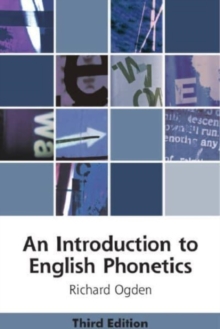
An Introduction to English Phonetics PDF
by Richard Ogden
Part of the Edinburgh Textbooks on the English Language series
Description
An introduction to the phonetic description of spoken English
The second edition of this distinguished textbook introduces undergraduates to the concepts, terminology and representations needed for an understanding of how English is pronounced around the world.
Assuming no prior knowledge, it guides the reader through the vocal tract and explains how the sounds of speech are made, offering an accessible and expanded introduction to areas including transcription, vowels and acoustic analysis. As far as possible, it uses naturally-occurring conversational speech so that readers are familiar with the details of everyday talk (and not just the careful pronunciations presented in dictionaries.) The book also includes a new concluding chapter that works through a piece of spoken data to show the reader how a more complete phonetic analysis can be conducted.
Examples are taken from around the English-speaking world, including North America, Australia, New Zealand and varieties of British English. The book takes an open-minded approach to what sounds of English might be significant for making meaning, and highlights the significance of word meaning, morphology, sociolinguistics and conversational interaction in phonetic analysis.
Key features
- Assumes no prior knowledge of phonetics
- Focuses on phonetics as a skill and encourages the reader to reflect on own speech
- Covers a range of forms of phonetic representation
- Each chapter contains a summary, exercises and further reading
- Expanded, accessible coverage in the areas of transcription and vowels
- Includes a new chapter on Sound and Structures which works through a piece of spoken data to show how a more complete phonetic analysis can be conducted
- See the Resources tab (below) for an audio example
Information
-
Download - Immediately Available
- Format:PDF
- Pages:240 pages
- Publisher:Edinburgh University Press
- Publication Date:06/02/2017
- Category:
- ISBN:9781474411776
Other Formats
- Paperback / softback from £18.09
- Hardback from £71.19
- Paperback from £13.75
- PDF from £16.99
- EPUB from £16.99
Information
-
Download - Immediately Available
- Format:PDF
- Pages:240 pages
- Publisher:Edinburgh University Press
- Publication Date:06/02/2017
- Category:
- ISBN:9781474411776










